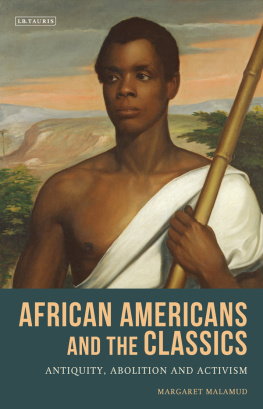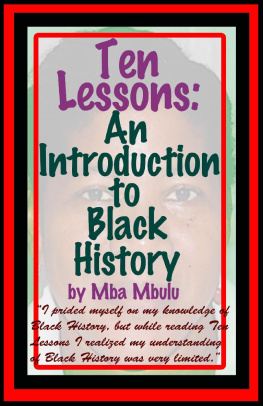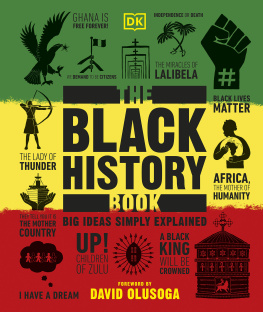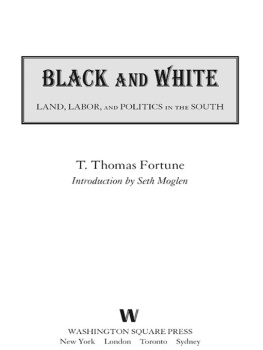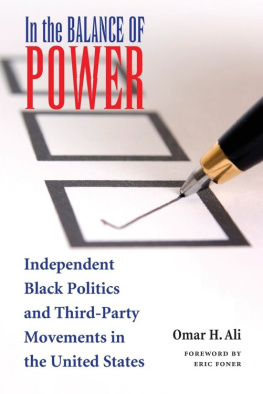This is the book that historians of classical reception in America have been awaiting for decades. The first book regarding African Americans relationship with the Greco-Roman classics that spans the first century and a half of the United States, its meticulous research and clear writing set the bar high for all future studies. The author of Ancient Rome and Modern America has written another classic.
Carl J. Richard, Professor of History, University of Louisiana at Lafayette
Malamud adds to our understanding of the vital, enduring influence of classical literature on the American experience with particular attention to abolitionist thought and the intellectual aspirations of African Americans of the eighteenth and nineteenth centuries. Her sensitive account acknowledges the ethical and political challenges involved in the African American pursuit of classical knowledge. Of particular interest is her insight into the role Egypt played in opening up ways to celebrate African identity.
Joy Connolly, Provost and Professor of Classics, CUNY Graduate Center, New York
This wonderful book offers an insightful account of African American engagement with classical Greece and Rome. As the author says, readers will be startled by the breadth and intensity of the engagement with Classics among African Americans. The classical texts were used in struggles over abolition, racism, and civil rights as well as in a variety of other contexts. Margaret Malamuds knowledge of the material is precise and impressive, her prose lucid and hard-hitting. She shows how much there is to learn from the role that Classics has played in African American history and culture.
Phiroze Vasunia, Professor of Greek, University College London
Published in 2016 by
I.B.Tauris & Co. Ltd
London New York
www.ibtauris.com
Copyright 2016 Margaret Malamud
The right of Margaret Malamud to be identified as the author of this work has been asserted by the author in accordance with the Copyright, Designs and Patents Act 1988.
All rights reserved. Except for brief quotations in a review, this book, or any part thereof, may not be reproduced, stored in or introduced into a retrieval system, or transmitted, in any form or by any means, electronic, mechanical, photocopying, recording or otherwise, without the prior written permission of the publisher.
Every attempt has been made to gain permission for the use of the images in this book. Any omissions will be rectified in future editions.
References to websites were correct at the time of writing.
Library of Classical Studies 12
ISBN: 978 1 78453 495 0
eISBN: 978 1 78672 028 3
ePDF: 978 1 78673 028 2
A full CIP record for this book is available from the British Library
A full CIP record is available from the Library of Congress
Library of Congress Catalog Card Number: available
List of Illustrations
The Runaway. Anti-Slavery Record, July 1837, p. 1.
Photograph of Alexander Crummell, Episcopalian pastor and abolitionist, ca. 1880.
Frontispiece to Phillis Wheatleys Poems on Various Subjects, published in London by Archibald Bell (1773), copyright Trustees of the British Museum.
William Sanders Scarborough, ca. 1913, Clarence Darrow Digital Collection, University of Minnesota Law Library.
Photograph of Booker T. Washington, ca. 1903, courtesy of the Library of Congress Prints and Photographs Division Washington, DC.
[3 February 2016].
Photograph of Dr. Anna Julia Cooper, courtesy of the Archives Center, National Museum of American History.
Photograph of Fanny Jackson Coppin, courtesy of the Library of Congress Prints and Photographs Division, Washington, DC.
Portrait of Sengbe Pieh (Joseph Cinqu), born in Sierra Leone and hero of the Amistad revolt, by Nathaniel Jocelyn (1840), New Haven Museum.
The Modern Medea, wood engraving after Thomas Satterwhite Nobles painting Margaret Garner, reproduced from Harpers Weekly, 18 May 1867.
William Wells Brown in the 1850s. Frontispiece illustration of William Wells Browns European travelogue, Three Years in Europe: Or, Places I Have Seen and People I Have Met. Hulton Archive/Getty Images.
Hiram Powers, The Greek Slave, carved 1873. Smithsonian American Art Museum, Washington, DC/Art Resource, New York.
John Tenniel, The Virginian Slave, Intended as a Companion to Powers Greek Slave, in Punch 20 (1851), p. 236.
Photograph of Frederick Douglass by Samuel Miller, ca. 184752, in the public domain.
Lydia Maria Child in the 1860s, reproduction of a photograph held in the Library of Congress.
Virginian Luxuriesca. 1800, painter unknown; Abby Aldrich Rockefeller Folk Art Museum.
Fauquier White Sulphur Springs, Fauquier Co. VA, colour lithograph by Edward Beyer, 1857, from his Album of Virginia; or, Illustration of the Old Dominion.
Photograph of the Confederate Soldiers Memorial at the Arlington National Cemetery in Virginia. Moses Ezekiel designed and executed the 32-foot bronze and marble memorial (1914).
Portraits of Hannibal and Cyprian, with Vignettes Illustrating African Character and Wrongs, abolitionist poster (1836), courtesy of the Library of Congress Prints and Photographs Division, Washington, DC.
William Wetmore Story, Cleopatra, 1858; this carving, 1869, in the Metropolitan Museum of Art, New York.
William Wetmore Story, The Libyan Sybil, 1860; carved 1861, in the Metropolitan Museum of Art, New York.
Edmonia Lewis, The Death of Cleopatra, carved 1876, in the Smithsonian American Art Museum.
Apollo Belvidere [sic], Negro, Young Chimpanzee. Reproduction of engraving in J. C. Nott and G. R. Gliddon, Types of Mankind; Or, Ethnological Researches, Based upon the Ancient Monuments, Paintings, Sculptures, and Crania of Races, and upon their Natural, Geographical, Philological, and Biblical History (Philadelphia: J. B. Lippincott, 1854), p. 458.

